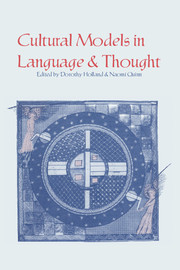Book contents
- Frontmatter
- Contents
- Preface
- List of Contributors
- Introduction
- Part I Presupposed worlds, language, and discourse
- Part II Reasoning and problem solving from presupposed worlds
- Part III The role of metaphor and analogy in representing knowledge of presupposed worlds
- 8 The cognitive model of anger inherent in American English
- 9 Two theories of home heat control
- 10 How people construct mental models
- Part IV Negotiating social and psychological realities
- Part V An appraisal
- Index
8 - The cognitive model of anger inherent in American English
Published online by Cambridge University Press: 05 June 2012
- Frontmatter
- Contents
- Preface
- List of Contributors
- Introduction
- Part I Presupposed worlds, language, and discourse
- Part II Reasoning and problem solving from presupposed worlds
- Part III The role of metaphor and analogy in representing knowledge of presupposed worlds
- 8 The cognitive model of anger inherent in American English
- 9 Two theories of home heat control
- 10 How people construct mental models
- Part IV Negotiating social and psychological realities
- Part V An appraisal
- Index
Summary
Emotions are often considered to be feelings alone, and as such they are viewed as being devoid of conceptual content. As a result, the study of emotions is usually not taken seriously by students of semantics and conceptual structure. A topic such as The Logic of Emotions would seem on this view to be a contradiction in terms, since emotions, being devoid of conceptual content, would give rise to no inferences at all, or at least none of any interest. We would like to argue that the opposite is true, that emotions have an extremely complex conceptual structure, which gives rise to wide variety of nontrivial inferences.
The conceptualization of anger
At first glance, the conventional expressions used to talk about anger seem so diverse that finding any coherent system would seem impossible. For example, if we look up anger in, say, Roget's University Thesaurus, we find about three hundred entries, most of which have something or other to do with anger, but the thesaurus does not tell us exactly what. Many of these are idioms, and they too seem too diverse to reflect any coherent cognitive model. Here are some example sentences using such idioms:
He lost his cool.
She was looking daggers at me.
I almost burst a blood vessel.
He was foaming at the mouth.
You're beginning to get to me.
You make my blood boil.
He's wrestling with his anger.
Watch out! He's on a short fuse.
He's just letting off steam. […]
Information
- Type
- Chapter
- Information
- Cultural Models in Language and Thought , pp. 195 - 221Publisher: Cambridge University PressPrint publication year: 1987
Accessibility standard: Unknown
Why this information is here
This section outlines the accessibility features of this content - including support for screen readers, full keyboard navigation and high-contrast display options. This may not be relevant for you.Accessibility Information
- 254
- Cited by
